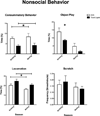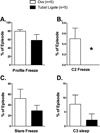Long-term ovariectomy alters social and anxious behaviors in semi-free ranging Japanese macaques
- PMID: 21835209
- PMCID: PMC3170512
- DOI: 10.1016/j.bbr.2011.07.046
Long-term ovariectomy alters social and anxious behaviors in semi-free ranging Japanese macaques
Abstract
Symptoms of anxiety and depression often occur in young women after complete hysterectomy and in older women during menopause. There are many variables that are hard to control in human population studies, but that are absent to a large extent in stable nonhuman primate troops. However, macaques exhibit depressive and anxious behaviors in response to similar situations as humans such as isolation, stress, instability or aggression. Therefore, we hypothesized that examination of behavior in ovariectomized individuals in a stable macaque troop organized along matriarchal lineages and in which individuals have social support from extended family, would reveal effects that were due to the withdrawal of ovarian steroids without many of the confounds of human society. We also tested the hypothesis that ovariectomy would elicit and increase anxious behavior in a stressful situation such as brief exposure to single caging. Japanese macaques (Macaca fuscata) were ovariectomized (Ovx) or tubal-ligated (intact controls) at 3 years of age and allowed to mature for 3 years in a stable troop of approximately 300 individuals. Behaviors were recorded in the outdoor corral in the third year followed by individual temperament tests in single cages. There was no obvious difference in anxiety-related behaviors such as scratching between Ovx and tubal-ligated animals in the corral. Nonetheless, compared to tubal-ligated animals, Ovx animals exhibited a significant decrease in (1) positive social behavior, (2) initiating dominance behavior, (3) time receiving grooming, (4) locomoting, (5) mounting behavior, and in (6) consort behavior. However, Ovx females exhibited a significant increase in (1) consummatory behavior and (2) object play compared to tubal-ligated controls. In the individual temperament tests, Ovx individuals exhibited an increase in anxiety-related behaviors. There was no difference in adrenal weight/body weight suggesting that neither group was under chronic stress. These data indicate that ovarian hormones enable females to successfully navigate their social situation and may reduce anxiety in novel situations.
Copyright © 2011 Elsevier B.V. All rights reserved.
Figures






Similar articles
-
The effect of long-term ovariectomy on midbrain stress systems in free ranging macaques.Brain Res. 2012 Dec 7;1488:24-37. doi: 10.1016/j.brainres.2012.09.035. Epub 2012 Oct 1. Brain Res. 2012. PMID: 23036275 Free PMC article.
-
Long-term ovariectomy decreases serotonin neuron number and gene expression in free ranging macaques.Neuroscience. 2011 Sep 29;192:675-88. doi: 10.1016/j.neuroscience.2011.06.003. Epub 2011 Jul 2. Neuroscience. 2011. PMID: 21763405 Free PMC article.
-
Effects of ovariectomy, social instability and social status on female Macaca fascicularis social behavior.Physiol Behav. 1986;36(6):1147-53. doi: 10.1016/0031-9384(86)90492-0. Physiol Behav. 1986. PMID: 3725919
-
Behavioral responses to ovariectomy and chronic anabolic steroid treatment in female cynomolgus macaques.Physiol Behav. 1999 Mar;66(1):95-100. doi: 10.1016/s0031-9384(98)00255-8. Physiol Behav. 1999. PMID: 10222479
-
Chronic estradiol replacement to aged female rats reduces anxiety-like and depression-like behavior and enhances cognitive performance.Psychoneuroendocrinology. 2009 Jul;34(6):909-16. doi: 10.1016/j.psyneuen.2009.01.004. Epub 2009 Feb 11. Psychoneuroendocrinology. 2009. PMID: 19216030 Free PMC article.
Cited by
-
Assessing anxiety in nonhuman primates.ILAR J. 2014;55(2):333-46. doi: 10.1093/ilar/ilu019. ILAR J. 2014. PMID: 25225310 Free PMC article. Review.
-
Exposure to a High-Fat Diet during Early Development Programs Behavior and Impairs the Central Serotonergic System in Juvenile Non-Human Primates.Front Endocrinol (Lausanne). 2017 Jul 21;8:164. doi: 10.3389/fendo.2017.00164. eCollection 2017. Front Endocrinol (Lausanne). 2017. PMID: 28785241 Free PMC article.
-
Long term sertraline effects on neural structures in depressed and nondepressed adult female nonhuman primates.Neuropharmacology. 2015 Dec;99:369-78. doi: 10.1016/j.neuropharm.2015.06.011. Epub 2015 Jun 24. Neuropharmacology. 2015. PMID: 26116816 Free PMC article.
-
Ovarian steroids regulate gene expression related to DNA repair and neurodegenerative diseases in serotonin neurons of macaques.Mol Psychiatry. 2015 Dec;20(12):1565-78. doi: 10.1038/mp.2014.178. Epub 2015 Jan 20. Mol Psychiatry. 2015. PMID: 25600110 Free PMC article.
-
The effect of long-term ovariectomy on midbrain stress systems in free ranging macaques.Brain Res. 2012 Dec 7;1488:24-37. doi: 10.1016/j.brainres.2012.09.035. Epub 2012 Oct 1. Brain Res. 2012. PMID: 23036275 Free PMC article.
References
-
- Heikkinen J, Vaheri R, Timonen U. A 10-year follow-up of postmenopausal women on long-term continuous combined hormone replacement therapy: Update of safety and quality-of-life findings. J Br Menopause Soc. 2006;12:115–125. - PubMed
-
- Conde DM, Pinto-Neto AM, Santos-Sa D, Costa-Paiva L, Martinez EZ. Factors associated with quality of life in a cohort of postmenopausal women. Gynecol Endocrinol. 2006;22:441–446. - PubMed
-
- Tangen T, Mykletun A. Depression and anxiety through the climacteric period: an epidemiological study (HUNT-II) J Psychosom Obstet Gynaecol. 2008;29:125–131. - PubMed
-
- Ozdemir S, Celik C, Gorkemli H, Kiyici A, Kaya B. Compared effects of surgical and natural menopause on climacteric symptoms, osteoporosis, and metabolic syndrome. Int J Gynaecol Obstet. 2009;106:57–61. - PubMed

